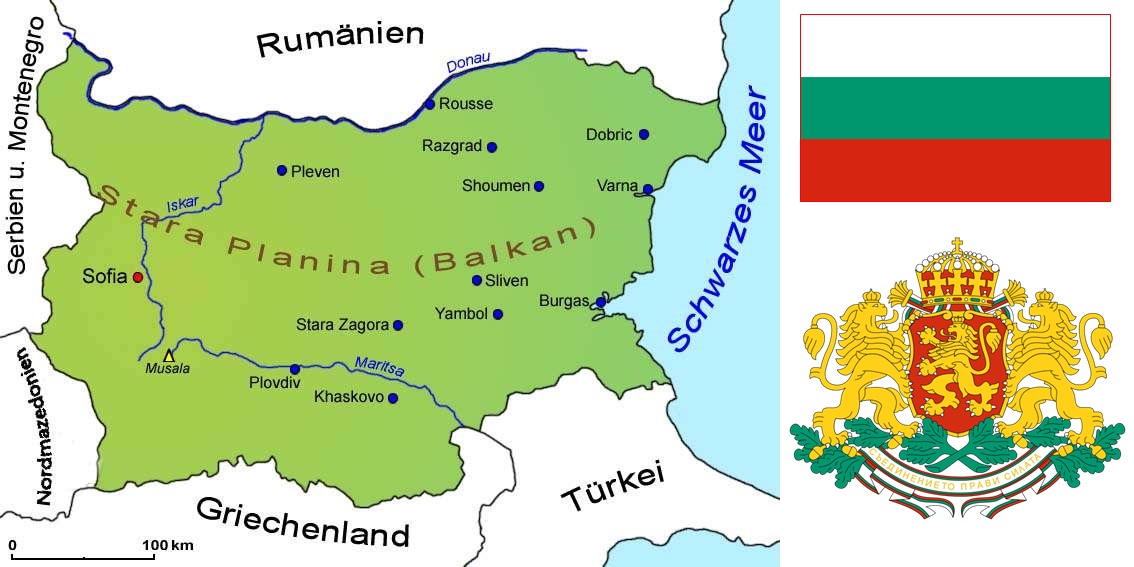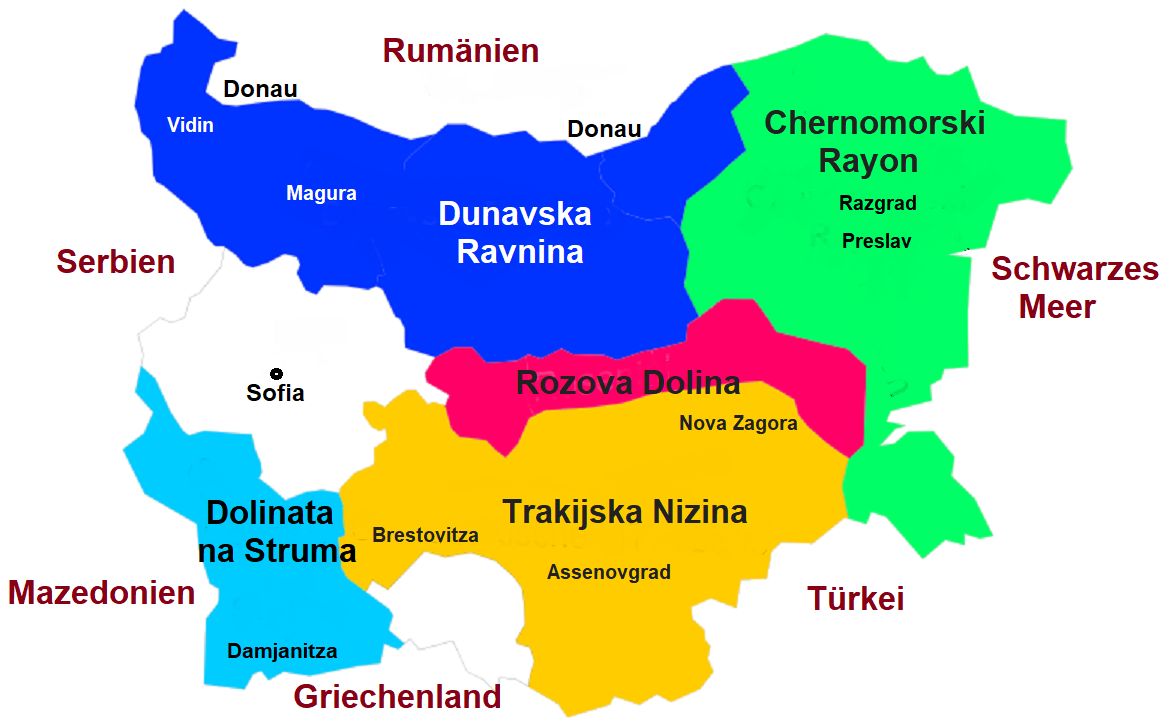Results
2,284 Results
Loading more Results ...
Loading more Results ...
Wine regions in Bulgaria 7 growing regions
Description to Bulgaria
The Republic of Bulgaria (Bulgarian: България) in south-east Europe with the capital Sofia covers 110,994 km². It occupies most of the eastern Balkan Peninsula and borders Romania to the north, Serbia and North Macedonia to the west, Greece and Turkey to the south and the Black Sea to the east. The state is divided into 28 provinces.

History
Bulgaria is one of the countries with the oldest wine-growing tradition in Europe. Based on archaeological finds and traditional texts, the origins on the territory of today's state point to a beginning as early as 5,000 years ago. Thracian tribes to the north and south of the Balkan Mountains cultivated wild vines and practised a pronounced cult in honour of the wine god Dionysus. The Thracians are credited with cultivating the oldest Bulgarian grape varieties and their ancestors such as Mavrud, Pamid, Dimyat, Melnik (Shiroka Melnishka) and Gamza (Kadarka). At the time of the Roman Empire, wine from Thrace was a sought-after export to Greece, Sicily, Asia Minor (Anatolia, Turkey) and Egypt.
Viticulture reached its peak in the Middle Ages thanks to the monasteries with their extensive vineyards. In 1393, the Bulgarian Empire was conquered by the Ottomans and remained under Islamic rule for 500 years until 1878. Only the production of table grapes was permitted. The ban on alcohol led to a serious threat to viticulture. The fact that a wine law was passed immediately after Ottoman rule in 1879, even before a constitution was passed, shows how important viticulture was considered by the state. However, viticulture was only resumed on a larger scale after the First World War and was exclusively practised by small winegrowers with autochthonous varieties.
Viticulture in the modern era
After the Second World War, wine production was gradually industrialised during the years of socialism. A collective system was introduced, viticultural schools were founded and European grape varieties were planted. In the 1960s, Bulgaria developed into a major wine exporting country. Until the 1960s, the largest quantities of wine were made from traditional varieties. Temperature-controlled fermentation tanks were the exception rather than the rule. As the wine industry became export-orientated, the proportion of domestic varieties increased. This, together with the introduction of high vine training and more modern cellar technology, led to major export successes.
The political change in 1989 led to a rethink. In 1990, the state winegrowing monopoly VINPROM was dissolved and most of the businesses privatised. This came as a surprise to the new owners, many of whom had no knowledge of viticulture. From 2000 onwards, however, things started to look up. Since then, the focus has been on quality rather than quantity. Many family wineries were established. In addition, the excellent wine-growing conditions attracted many foreign investors to Bulgaria. Accession to the EU in 2007 opened up good sales prospects on the European market. The simultaneous loss of other markets (Russia, North Africa) increased the quality of the wine.
Wine-growing regions
There are five wine-growing regions, shown in colour on the map, which are divided into sub-regions. The climate and soil conditions provide excellent conditions for viticulture. The country lies in the centre of the Balkan Peninsula at the same latitude as Tuscany in Italy and Bordeaux in France, between the temperate continental and Mediterranean climate belts. The various mountain formations such as Pirin, Rhodope and above all the Balkan mountain range running east-west through the whole country protect the country from Aegean and Adriatic climatic influences. The humid Atlantic influences play the largest role in determining the climate. The vineyards are located on the numerous mountain foothills, in the side valleys and the lowlands of the countless river courses.

Dunavska Ravnina (Danube Plain) - North
The gently undulating landscape between the Danube and the Balkan Mountains is criss-crossed by many rivers. The wine-growing areas are Biala, Dve Mogili, Ljaskovetz, Lom, Magura, Nikopol, Novo Selo, Orjahovo, Pavlikeni, Pleven, Rousse, Suhindol, Svischtov and Vidin. The region is known for its red wines, dessert wines and sparkling wines.
Chernomorski Rayon (Black Sea region) - East
The region borders the Danube and Romania to the north and the Black Sea coast to the west. The area includes the geographical units of the Dobrudja Plain and the Ludogorie Hills in the north to the Strandja Mountains in the south. The growing areas are Burgas, Euxinograd, Kableshkovo, Kavarna, Khan Krum, Novi Pazar, Pomorie, Preslav, Razgrad, Shumen, Silistra, Targovishte and Varn. The best Bulgarian white wines come from here.
Rozova Dolina (Rose Valley or Lower Balkan region) - Centre
The region (southern flank of the Balkan Mountains) extends to the east on all the flat foothills of the Balkan and Sredna Gora Mountains in the vicinity of the towns of Karlovo, Karnobat, Nikolaevo, Schivatchevo, Slaviantzi, Sliven Straldja and Sungurlare. The region is known for its dessert white wines and grape distillates (Elenovo, Straldja, Karnobat, Sungurlare).
Trakijska Nizina (Thrace Valley) - South
The region stretches across the Thracian lowlands on the border with Turkey, south of the Balkan and low mountain ranges, in the large valleys of the Maritsa and Tundsha rivers. In the south-east, it is bordered by the foothills of the Sakar Mountains. The climate is temperate continental. Cultivation areas are located around the municipalities of Assenovgrad, Brestovitza, Brezovo, Elhovo, Harmanli, Haskovo, Ivaylovgrad, Jambol, Ljubimetz, Nova Zagora, Ognjanovo, Orjahovitza, Parvomay, Pazardjik, Perushtiza, Peshtera, Plovdiv, Saedinenie, Septemvri, Sliven, Stambolovo, Stara Zagora and Tchirpan. Here, 70% red and 30% white wine varieties are cultivated. The region is known for its sparkling white and rosé wines.
Dolinata na Struma (Struma Valley) - south-west
The region lies in the narrow valley of the Struma River on the border with Greece and North Macedonia. It is particularly known for its red wines from the Shiroka Melnishka (Melnik) and Ranna Melnishka Loza (early ripening Melnik) varieties. The growing regions are Blagoevgrad, Boboschevo, Damjanitza, Gotze Deltchev, Harsovo, Kapatovo, Kresna, Kulata, Levunovo, Melnik, Petrich, Sandanski, Smotchevo and Vinogradi. Mainly red wine varieties are cultivated here on around 75% of the area.
Grape variety index
In 2022, the vineyards covered 65,261 hectares of vines and the wine production volume was 747,000 hectolitres. At the beginning of the 2000s, the vineyards still covered around 150,000 hectares. After joining the European Union in 2007, extensive grubbing-up measures were carried out. Red wines make up around two thirds and white wines one third. The list of grape varieties with the top 18 (Kym Anderson statistics):
| Grape variety | Colour | Synonyms or Bulgarian names | hectares |
| Merlot | red | - | 10.050 |
| Cabernet Sauvignon | red | - | 9.327 |
| Pamid | red | Plovdina, Roșioar | 6.874 |
| Rkatsiteli | white | Rkaziteli | 5.415 |
| Misket Cherven | white | Cherven Misket, Misket Rozov | 4.349 |
| Muscat Ottonel | white | Musket Otonel, Misket | 3.679 |
| Chardonnay | white | - | 3.087 |
| Dimyat | white | Dymiat, Misket Slivenski, Smederevka | 2.998 |
| Shiroka Melnishka | red | Melnik, Shiroka Melnishka Loza | 1.205 |
| Mavrud | red | Mavroudi, Mavroudi Voulgarias | 1.193 |
| Kadarka | red | Gamza, Gumza, Gymza | 1.161 |
| Syrah | red | - | 804 |
| Trebbiano Toscano | white | - | 738 |
| Sauvignon Blanc | white | - | 637 |
| Gewürztraminer | white | Mala Dinka | 591 |
| Pinot Noir | red | - | 342 |
| Aligoté | white | - | 285 |
| Cabernet Franc | red | - | 240 |
Wine law
In August 2009, the EU wine market regulation came into force for all EU member states with fundamental changes to wine designations and quality levels. Since 2012, Bulgaria has had the following new designations and quality levels (see also in detail under Quality system):
- Vino bulg. Вино (formerly the now forbidden term table wine) = wine
- PGI = Regionalno Vino or country wine
- PDO = quality wine
Vino = wine
Wines without designation of origin. These must have a natural alcohol content of at least 7.5% vol.
PGI (Protected Geographical Indication) = regional wine
A country wine with a protected geographical indication. The old designation RV (Regionalno Vino) is no longer in use. There are the two country wine areas PGI Danube Plain (Northern Bulgaria) and PGI Thrace Valley (Southern Bulgaria).
PDO (Protected Designation of Origin) = quality wine
A quality wine with protected designation of origin. The old designations GNP (Garantirano Naimenovanie sa Proischod = Guaranteed) and GKNP (Garantirano i Kontrolirano Naimenovanie sa Proischod = Guaranteed and Controlled) are no longer in use. Quality wines, on the other hand, may only come from certain certified regions. Their special characteristics are therefore always attributable to the specific vineyard and region. Quality wines are also further classified (see below). There are around 50 PDO areas.
Supplementary quality designations
The supplementary quality designations provide information on grape ripeness, type of vinification and ripening period.
- PGI: Premium (1 grape variety from the growing region), Reserve (1 year) and Barrique(barrique ageing)
- PDO: Premium (1 grape variety from the growing region), Premium Barrique (first ageing), Reserve (1 year), Special Reserve (1 grape variety, 2 years), Special Selection (1 grape variety, 3 years), Collection (1 grape variety, 4 years), liqueur wine (up to 15% vol.) and wine made from overripe or botrytised grapes.
Producers
The best-known producers in Bulgaria include Assenovgrad, Belvedere Group (Domaine Katerina, Domaine Menarda Stara Zagora, Sakar, Oriachovitza), Bessa Valley, Black Sea Gold, Domaine Boyar (Blueridge, Korten), Burgas, Damianitza, Haskovo, Magura Winery, Miroglio, Peshtera Group, Pomorie, Rousse, Stork Nest Estates (formerly Svishtov), Stambolovo, Suhindol, Targovishte, Todoroff, Vinex Slavyantzi, Vini Sliven and Yambol.
Map: © Goruma
Flag: by SKopp, Public domain, Link
Coat of arms: by Пакко, Public domain, Link
Source 1st paragraph: WIKIPEDIA Bulgaria
find+buy for Bulgaria 5
Recent wines 86
 Velis Vineyards GmbH
— Oberthrakische Tiefebene
2019 Cuvée "Heaven's Door Black Label"
86 WP
very good
10.70 €
Velis Vineyards GmbH
— Oberthrakische Tiefebene
2019 Cuvée "Heaven's Door Black Label"
86 WP
very good
10.70 €

 Velis Vineyards GmbH
— Oberthrakische Tiefebene
2020 Cabernet Sauvignon "Heaven's Door Blue Label"
84 WP
good
14.90 €
Velis Vineyards GmbH
— Oberthrakische Tiefebene
2020 Cabernet Sauvignon "Heaven's Door Blue Label"
84 WP
good
14.90 €

 Velis Vineyards GmbH
— Oberthrakische Tiefebene
2020 Syrah "Heaven's Door Blue Label"
83 WP
good
14.90 €
Velis Vineyards GmbH
— Oberthrakische Tiefebene
2020 Syrah "Heaven's Door Blue Label"
83 WP
good
14.90 €

 Domaine Boyar
— Oberthrakische Tiefebene
2018 Sauvignon Blanc Dry "Quantum"
84 WP
good
Up to 6.00 €
Domaine Boyar
— Oberthrakische Tiefebene
2018 Sauvignon Blanc Dry "Quantum"
84 WP
good
Up to 6.00 €
